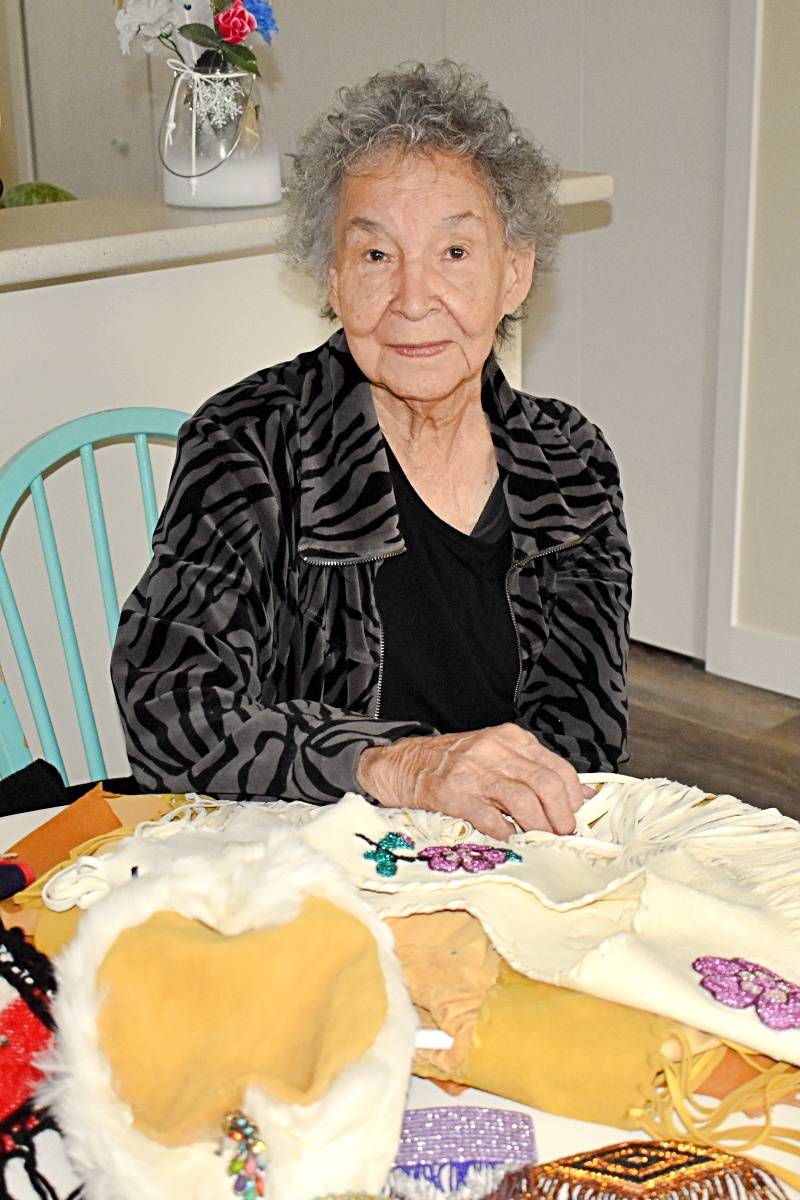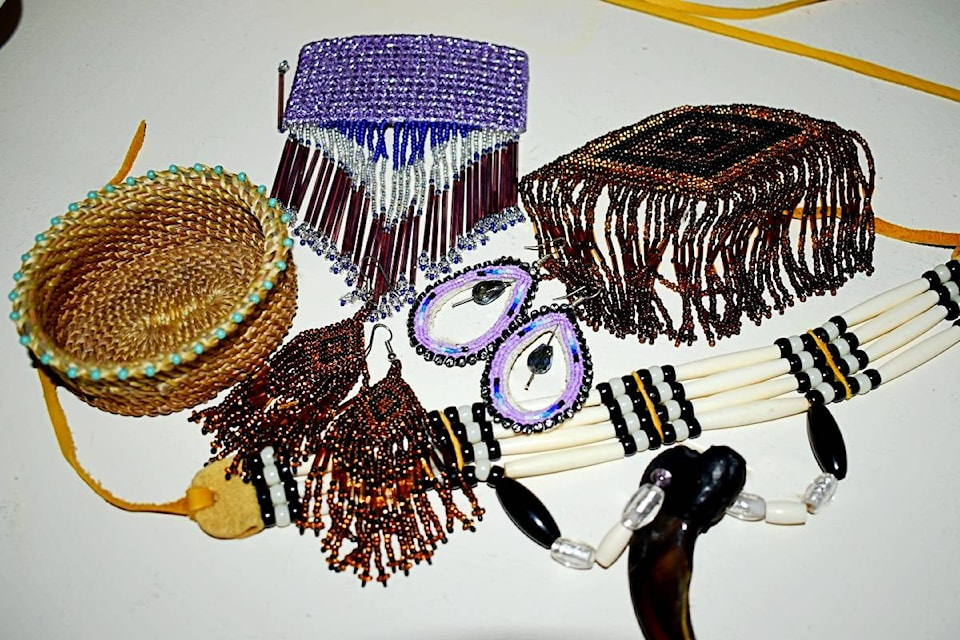To some in the Prince Rupert community 89-year-old Margaret Harris is known as Grandma Harris, but she is much more than that. As a traditional First Nations dance teacher, moccasin maker, regalia maker, drummer, parent, grandparent and foster parent to 17 children, Margaret Harris is an icon. She is the initiator of Prince Rupert Aboriginal day, and a pillar of strength in keeping alive and passing along traditional ways to younger generations.
Margaret’s story is a long and colourful one that resonates the heart-beat of life and transitioning times in the city. The Northern View was honoured to sit down with her in her new home at Cedar Village Seniors Housing Society and experience first hand what she has to share. As I got to know about Margaret’s life and contributions, I couldn’t picture her living anywhere more apt than at the traditionally styled village, with woven-cedar-hat shaped roofs and freshly carved totem poles greeting visitors at the entrance. The beautiful surroundings are as dignified and serene as this respected Elder.
As I entered Margaret’s apartment, the teacher in her and the desire to share knowledge was apparent. She had already laid out traditional items for me to see. Margaret showed me a customary deer hide tunic that she had made more than 35 years ago. Her care of the garment was obvious as it still looked brand new. She explained the clothing was not sewn, but it was laced together with sinew. The clothing was worn by First Nations she said, before “first contact” with white settlers. She then explained to me about the coloured trim on a black wool shawl which represents her Metis heritage.
“Metis simply means I have Scottish in me. The red represents me the Indian, the yellow represents the sun, the white represents you - the white people, the blue represents the sky and green is Mother Earth,” she said.
Margaret came to Prince Rupert in 1951 as a 20-year-old young woman to work at the Miller Bay T.B. Hospital. She grew up as a Metis member of the Cree Nation in Churchill, Manitoba, a town she said was between 2000 to 3000 people. Raised by a single mother, her father died when she was just three-years-old, leaving behind Margaret and her seven siblings.
“We didn’t have very much but we were taught our culture. How to hunt and fish and dry meat and smoke our hides.” Margaret said.
The family was always kept busy with chores like making their own clothes and preparing food.
“Well, during the day, in those days when I was young, we had chores. We had to pack our wood, we had to pack our ice or water. If you didn’t do all that, you froze or you would die of thirst. So we were always busy.”
Margaret said growing up during the depression was hard in a two room house.
“We didn’t have much but we had a lot of love.”
Eventually Margaret went to live with an Aunt. She remembers when she was around seven-years-old she nearly froze to death close to Christmas.
“My uncle was loading up my cousins - I had Norwegian cousins, on the sleigh to go the Christmas party. I thought if I just stood there he won’t leave me behind. But, he did.”
A big winter storm hit as Margaret stood at the side of road waiting for her uncle to come back. Dressed in just a cardigan and dress, her legs quickly froze. She doesn’t remember much about that ordeal, but does remember being in hospital to recover and going to live with her aunt who raised her from that point on.
READ MORE: National Indigenous Peoples Day celebrations at B.C. university go online
At 15, Margaret left school to start working. She said she loves house-work and when she was old enough she moved to Prince Rupert. She met her husband Ken Harris at a dance, but at the time she was more interested in a another boy who was there. Ken was persistent in his courting efforts Margaret said. He broke tradition to marry her. Ken was a hereditary chief and when they got married in 1953 Margaret become the ‘first lady’.
Soon after they got married, the young couple took in three children who Ken’s mother had been raising. This would be just the start of their family and the many foster children that they nurtured and looked after. At one point they had more than 17 children in the house. They lived in the same house on Eighth East for 30 years.
“We had so many children because there were no foster home in those days. They used to have a hard time finding foster homes,” Margaret said. “Social workers just kept bringing me more and more.”
Margaret kept teaching them and loving them. Many children have been through her door with behavioral and emotional difficulties, she said. She told me about a young boy from a different region who had been brought to her, traumatized at seeing his family burned to death. He hadn’t spoken since the occurrence. With-in two months of receiving him into her open arms, he was talking again. She said all her kids had a chore and she taught them to dance. Another boy came to her with behavioral challenges. She taught him his lineage which was one of First Nations hierarchy and to be proud of who he was. After a while his own family didn’t recognize him from his changed behavior. He grew up to become a social worker and now helps children like he was.
“I just made them feel at home and they were loved and that they were worthwhile.”
Margaret said that some of the children still call her at Christmas time to send love and jokingly ask for their allowance. Every Christmas she would give them money so they could go to the movies and buy popcorn as a treat.
During her life in Prince Rupert, Margaret founded an organization to assist First Nations people to put on functions and provide donations to anyone in the community who needed help. The Native Benevolent Organization (NBO) still exists today, Margaret said.
Soon after the start up of the NBO, Margaret was approached by Prince Rupert Mayor, Peter Lester, with the request to help the city recognize and celebrate First Nations culture. At first Margaret wondered what she could do to assist. She relied on the idea of traditional Cree spring-time muskrat trapping and the ceremonial pow-wows and dancing. She decided to initiate a cultural celebration during the salmon run. The celebration was called “Indian Day”, which later was renamed to “Aboriginal Day”.
The first year they had very little to work with, Margaret said. She had only two artists. Culturally much had been lost due to the government outlawing First Nations recognition and cultural celebrations.
“We had no carvers, no dancers. I went to the museum to see if I could borrow some artifacts. They said ‘No, we don’t lend them.’ My mother-in-law had a few, so we used those,” Margaret said. “There were no drums, there was nothing. We had to use a pot for drumming.”
The first year of the celebrations, Margaret said she was kept much busier than anticipated because more than 1000 people attended.
“The first year we were so busy. We were happy. I was proud. The people in Prince Rupert are supportive and they just support,” she said. “It just got bigger and bigger. We had pamphlets on the ferry. We had match-books with pictures. We had a lot of people doing Indian Days. People looked forward to it because it was the only native culture that was happening at the time.”
Margaret said in the late 1960s and early 1970s a resurgence for traditions started to occur. She started to teach regalia making and dancing. Artists started carving again. She opened a store in 1968 which sold traditional arts and crafts. She would host carvers in the back of the store, which she ran for 10 years.
Margaret’s efforts at re-instituting First Nations traditions and culture didn’t stop in just Prince Rupert. She would go to Alaska to teach dance several times a year, to guide people back to connecting with their lost culture.
Margaret’s outstanding achievement and commitment to breathing new life into old ways and traditional culture didn’t go unnoticed. In 1969 she was awarded a Certificate of Achievement from the City of Prince Rupert and from the Lieutenant Governor of British Columbia.
For a while Ken and Margaret lived in Vancouver where she started a group called “Traditional Mothers”. The group focused on helping young women with addictions, those living risky life styles and those without homes. Margaret gave these women support and guidance. She said, when she helped them to find their identities they would begin to heal by learning about their heritage and culture.
It wasn’t just women of First Nations, it was women of all nations she was teaching to help find themselves. It was through this endeavour that Margaret gained her moniker of “Grandma Harris.”
Grandma Harris returned to Prince Rupert two years ago. She moved into Cedar Village in December 2019. She loves the companionship and community spirit there.
COVID-19 has slowed things down for her a bit, she said. She thinks she’d like to teach some classes when it’s over. In the meantime she has become involved in the evening drumming that the residents at Cedar Village participate in during COVID-19.
“I’m 89. I’ve been teaching a long time … I’m at the age where I get tired. I teach drumming, I teach moccasin making, and also the regalia,” Margaret said.
“I’m not bored. I have something to do every day.”
READ MORE: National Aboriginal Day continues with a new name
K-J Millar | Journalist
Send K-J email
Like the The Northern View on Facebook
Follow us on Twitter

